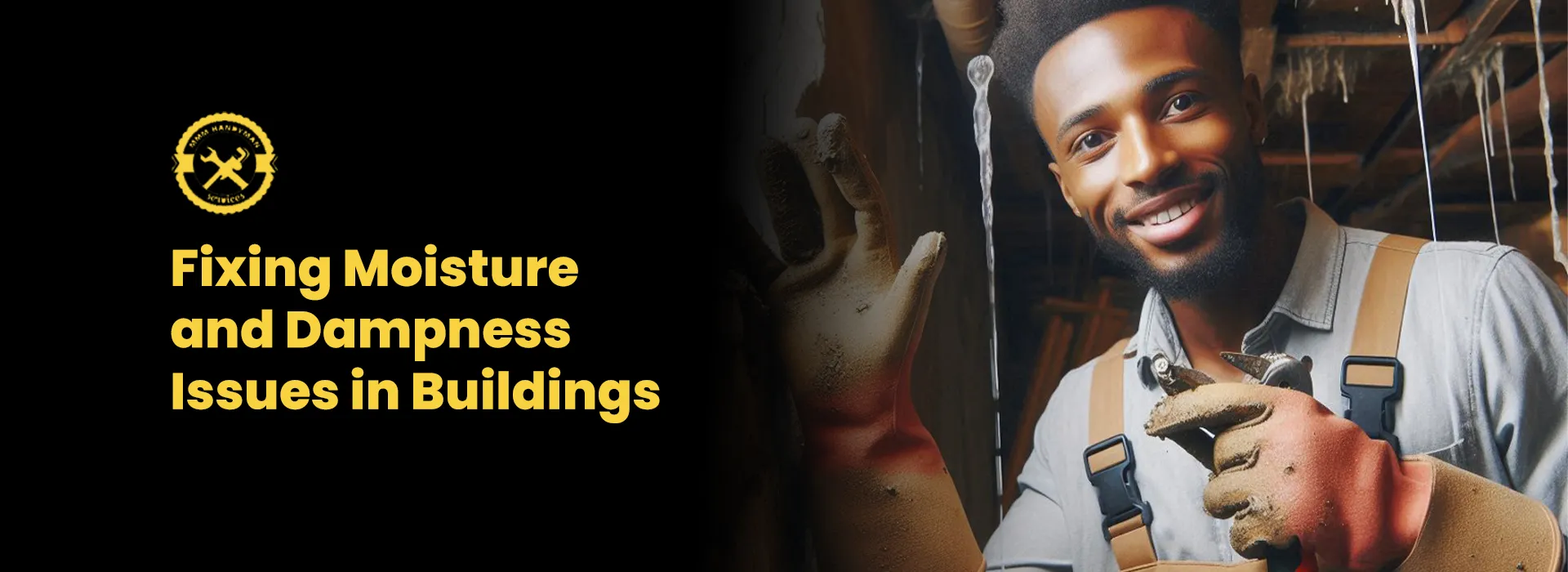
Quick Guide to Fixing Moisture and Dampness Issues in Buildings
Moisture and dampness in buildings can lead to a host of problems, from structural damage to health concerns. If you’ve noticed musty odors, peeling paint, or mold growth in your home or office, it’s time to take action. Here’s a quick guide to understanding and fixing these issues, delivered in a friendly, humanized manner.A handyman can be a great resource for fixing moisture and dampness issues in your building, especially if the problems are not too extensive.
Understanding the Causes of Moisture and Dampness
Before you can fix moisture issues, it’s crucial to understand what causes them. Here are some common culprits:
Poor Ventilation: Inadequate airflow can trap moisture inside. This is especially common in bathrooms, kitchens, and basements.
Leaks: Roof leaks, faulty gutters, and plumbing issues can introduce water into your walls and foundation.
Rising Damp: Groundwater can seep into the walls and floors of your building, particularly in older structures that lack proper damp-proofing.
Condensation: This occurs when warm, moist air meets a cool surface, creating water droplets. This is common in winter months when indoor heating is high.
Humidity: High outdoor humidity can infiltrate your building, particularly if windows and doors are not sealed properly.
Assessing the Problem
Once you’ve identified the potential causes, the next step is to assess the extent of the problem:
Visual Inspection: Look for visible signs of dampness, such as water stains, mold, or peeling wallpaper.
Smell Test: A musty odor is often a telltale sign of mold growth.
Moisture Meter: If you’re serious about fixing the issue, consider investing in a moisture meter. This tool can help you measure moisture levels in various materials.
DIY Solutions for Moisture and Dampness
If the problem seems manageable, here are some DIY solutions you can try:
Improve Ventilation: Open windows, use exhaust fans, and consider installing vents to increase airflow. If your building has an HVAC system, make sure it’s functioning properly.
Fix Leaks: Check for leaks in your roof, gutters, and plumbing. Repairing these can significantly reduce moisture intrusion.
Seal Cracks and Gaps: Use caulk to seal any gaps around windows, doors, and walls. This can help prevent outside moisture from entering.
Use a Dehumidifier: If humidity is a constant issue, a dehumidifier can help pull excess moisture from the air, creating a more comfortable environment.
Insulate: Insulating your walls and roof can help regulate temperature and reduce condensation. Consider using insulation materials that are resistant to moisture.
Mold Removal: If you find mold, clean it up using a mixture of water and detergent, or a specialized mold remover. Always wear protective gear when dealing with mold.
When to Call the Professionals
Some moisture issues are beyond DIY fixes. Here are a few scenarios where professional help is warranted:
Extensive Mold Growth: If the mold covers a large area (greater than 10 square feet), it’s best to hire a professional mold remediation service.
Structural Damage: If you suspect that dampness has compromised the integrity of your building, such as weakened beams or crumbling walls, contact a structural engineer.
Persistent Dampness: If your efforts to fix the problem have not been successful and dampness persists, a professional inspection can identify hidden issues and provide effective solutions.
Prevention Tips for the Future
After you’ve addressed existing moisture issues, it’s essential to take steps to prevent future problems:
Regular Maintenance: Inspect your property regularly for signs of leaks and dampness. Early detection can save you from costly repairs.
Keep Gutters Clean: Ensure that your gutters and downspouts are clear of debris to facilitate proper water drainage away from your building.
Check Grading: The land around your building should slope away from the foundation. If it doesn’t, consider regrading the landscape.
Use Moisture Barriers: If you’re renovating or building, consider installing moisture barriers in areas prone to dampness, such as basements and crawl spaces.
Monitor Humidity Levels: Use hygrometers to monitor indoor humidity levels. Ideally, they should be kept between 30-50%.
Dealing with moisture and dampness in buildings doesn’t have to be daunting. By understanding the causes and implementing the right solutions, you can create a healthier living or working environment. Whether you tackle these issues yourself or seek professional help, taking action is the key to preserving your property and ensuring the well-being of its occupants. Remember, your home is your sanctuary—keeping it dry and comfortable is worth the effort!

